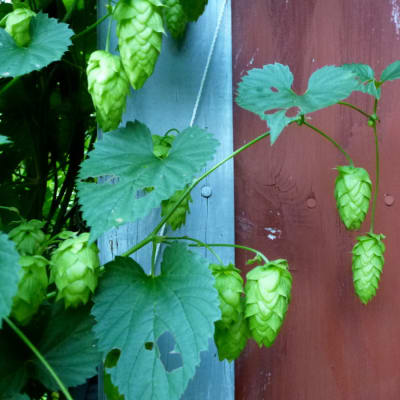Hops

Hops Humulus lupulus
Beautiful twining vine covers a trellis, archway or the entire side of a barn. Our favorite live awning to shade out the summer sun. Green lobed leaves, bristly stems, and insignificant greenish flowers, followed in late summer by the hops: papery aromatic cone-like strobiles used medicinally and in brewing for more than 1000 years. Herbalist John Christopher recommended the strobile tea as “a powerful, stimulating and relaxing nerve tonic.” For brewing, there are basically two types of hops. Aroma hops are used for flavoring, finishing or conditioning brews. Bitter hops have more alpha acids and are used to impart bitterness. Native to Eurasia.
Growing Hops
- Soil: Adaptable, but prefers rich light well-drained soil. Top-dress with manure or compost each spring.
- Sun: Full, but will tolerate some shade.
- Pollination: You need only one variety.
- Spacing: In hills 3' apart, 1 or 2 plants per hill.
- Planting: Plant hops where you’re sure you want them—they’ll be hard to get rid of once established. Prepare planting holes with plenty of compost, manure or other slow-release organic fertilizer. Plant rhizomes with buds pointing up and cover with 1–2" loose soil. Appreciates frequent light waterings and mulch the first year.
- Training: Vines may grow up to 25' in a single season, and do best if they are trained onto strong twine 12–30' high, supported by a trellis, wire, pole, tree branch or south-facing building. When young vines are about 1' long, select the most vigorous 2 or 3 shoots per hill and remove the rest; gently wrap the vines clockwise on the twine to get it started.
- Harvest: Pick the hops when they are papery but still slightly sticky and filled with yellow powder. Dry hops thoroughly before use. Spread on screens in a dry room, they will dry in a few weeks. Dried hops freeze well.
- Pruning: Vines die back to the ground in fall and rebound vigorously in spring. Just cut back the dead vines after frost. To help control vigor, prune roots by cutting a 2–3' circle with a shovel around the base of the plant in spring.



